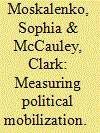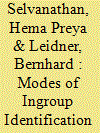|
|
|
Sort Order |
|
|
|
Items / Page
|
|
|
|
|
|
|
| Srl | Item |
| 1 |
ID:
087764


|
|
|
|
|
| Publication |
2009.
|
| Summary/Abstract |
In this paper we review and extend measures of political mobilization: the increasing extremity of beliefs, feelings, and behaviors in support of inter-group conflict. Building on previous research, we introduce the Activism and Radicalism Intention Scales (ARIS). The Activism Intention Scale assesses readiness to participate in legal and non-violent political action, whereas the Radicalism Intention Scale assesses readiness to participate in illegal or violent political action. In ad-hoc samples of U.S. and Ukrainian undergraduates, and in an Internet panel survey representative of the U.S. population, Activism and Radicalism intentions formed two correlated but distinguishable dimensions. The popular "conveyor belt" metaphor of radicalization (implying that activism leads easily to radicalism and that most radicals emerge from activism) found only mixed support in our results. Discussion suggests the potential usefulness of the ARIS for learning about how individuals move from political attitudes and beliefs to political action, including political violence and terrorism.
|
|
|
|
|
|
|
|
|
|
|
|
|
|
|
|
| 2 |
ID:
087766


|
|
|
|
|
| Publication |
2009.
|
| Summary/Abstract |
In this paper we review and extend measures of political mobilization: the increasing extremity of beliefs, feelings, and behaviors in support of inter-group conflict. Building on previous research, we introduce the Activism and Radicalism Intention Scales (ARIS). The Activism Intention Scale assesses readiness to participate in legal and non-violent political action, whereas the Radicalism Intention Scale assesses readiness to participate in illegal or violent political action. In ad-hoc samples of U.S. and Ukrainian undergraduates, and in an Internet panel survey representative of the U.S. population, Activism and Radicalism intentions formed two correlated but distinguishable dimensions. The popular "conveyor belt" metaphor of radicalization (implying that activism leads easily to radicalism and that most radicals emerge from activism) found only mixed support in our results. Discussion suggests the potential usefulness of the ARIS for learning about how individuals move from political attitudes and beliefs to political action, including political violence and terrorism.
|
|
|
|
|
|
|
|
|
|
|
|
|
|
|
|
| 3 |
ID:
175338


|
|
|
|
|
| Summary/Abstract |
People on both sides of an intergroup conflict undertake various forms of collective action to seek justice for their own group. Three studies investigated whether modes of ingroup identification promoted distinct preferences for justice, which subsequently shaped the form of collective action people supported. Among Arab (Study 1, n = 148) and Jewish Israelis (Study 2, n = 294), we found that ingroup glorification promoted a desire for retributive justice, which predicted support for nonnormative collective action, whereas ingroup attachment promoted a desire for restorative justice, which predicted support for normative collective action. Further, during a period of conflict escalation (i.e., Palestinian protests at the Gaza Strip), emphasizing retributive or restorative justice produced differential effects on the links from glorification and attachment to nonnormative and normative collective action (Study 3, n = 546). This research advances our understanding of when and how collective action can escalate intergroup conflict.
|
|
|
|
|
|
|
|
|
|
|
|
|
|
|
|
|
|
|
|
|